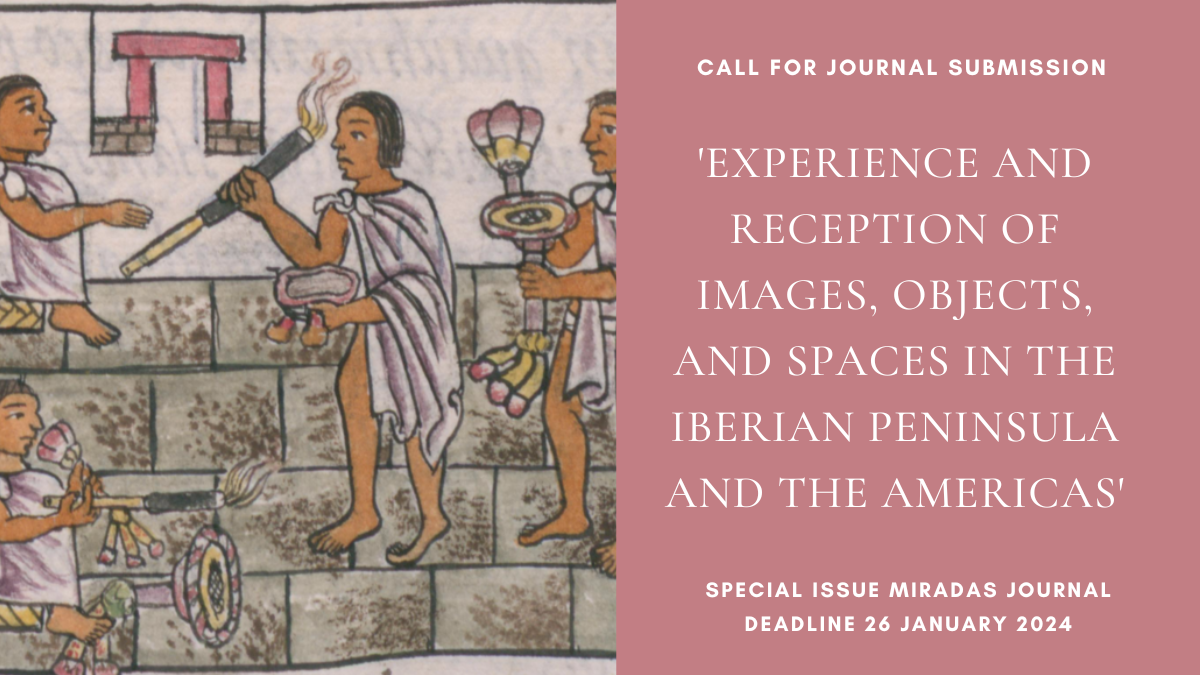The next Special Issue of the journal “Miradas. Journal for the Arts and Culture of the Americas and the Iberian Peninsula” (Autumn 2025), published by the University of Heidelberg, will focus on the analysis of the experience and reception of images, objects, and spaces in the territories of the Iberian Peninsula and the Americas.
The proposed issue responds to one of the main paradigm shifts that have taken place in Art History over the last few decades, which has led to placing in the spotlight not only objects, images, and spaces themselves, but also their relationship with their beholders and users. Thus, research focused on topics such as perception, interaction, and how human beings respond to objects and images has reached a great impetus. This new interest in Art History has been developed in parallel to other fields in the Humanities and Social Sciences. Indeed, it can be traced back to the impact that Reception Theory had on the field of Literary Studies and Communication since the 1960s and 70s. As a result of this growing interest, it can be noted, for instance, the development of new fields such as Neuroaesthetics, that is, cognitive neuroscience applied to the aesthetic experience, which focuses on the study of psychological processes and their neural correlates when contemplating or interacting with an image or object.
On this basis, this special issue aims to explore the various nuances of experience and reception from a multi-focal perspective, bringing together contributions with a fundamental theoretical and methodological approach along with others that focus on specific case studies related to the territories of the Iberian Peninsula and the Americas. Considering the aims of the journal Miradas, we especially welcome proposals that deal with transcultural aspects of these globally connected regions, both in past historical periods and in contemporary times, with a particular interest in contemporary reception practices in the Américas.
The main thematic lines are:
– The application of new methodologies, techniques, and technologies for the study of reception and the cognitive and neural processes involved in it (eg. eye-tracking, fMRI, EEG/ERPs), as well as other approaches such as the examination of surfaces using tools such as densitometers or protein analysis used in areas such as biocodicology.
– Studies reflecting on how and to what extent the advances and new techniques developed in areas such as Neuroscience and Psychology during the last decades led to obtaining empirical results that have confirmed, consolidated or contradicted the theoretical contributions on reception posited in the Humanities since the 19th century.
– The analysis of the modes of interaction, attitudes, and psychological and behavioural responses to spaces, objects, and images produced in a time span close to that of their contemplation. In this sense, proposals that analyse the experiences of travellers who contemplate productions in a geographical or cultural context different from their own will be especially welcome. Similarly, it will be relevant to address how different forms of collective or personal identity (such as gender, race, or class) have a defining influence on reception, interaction, and interpretation.
– The analysis of the modes of interaction, attitudes, and psychological and behavioural responses to spaces, objects, and images produced in previous historical times. Here, proposals might deal, for instance, with the variations in the reception of certain objects over time, observing the differences in how productions from past times are perceived and interpreted, whether because they do not conform to the beholder’s aesthetic precepts, because they have undergone processes of resignification, or because they represent values or systems with which the beholder/user no longer identifies (e.g. damnatio memoriae or protest actions).
Proposals may be sent in Spanish, Portuguese, English, and German before January 26, 2024 to the editors of the Special Issue: Alicia Miguélez (Art History Department, NOVA University of Lisbon, alicia.miguelez@fcsh.unl.pt) and Sara Carreño (Art History Department, University of Santiago de Compostela, sara.carreno@usc.es). They will consist of:
- Title
- Abstract (max. 300 words)
- 3-5 key words
- Short CV (max. 100 words)
In addition to proposals for papers, proposals related to this same theme may also be sent for the sections “Artworks Recalled”, Sources, and Reviews, which form part of the contents that the journal Miradas regularly publishes. In these cases, it will be enough to send the details of the work to be analysed or reviewed, with an image in the case of “Artworks Recalled”.
